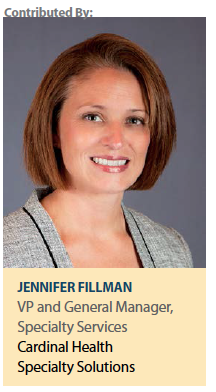 As the process of bringing new products to market has become increasingly complex, so too have decisions around distribution and channel strategy. When thinking about how to get products into the hands of providers and patients in the right place and at the right time, pharmaceutical companies have a myriad of options to consider beyond traditional “pick, pack, and ship" services. Today, the optimal channel plan starts with a keen understanding of the unique needs of the drug product and the specific challenges it may face as it comes to market.
As the process of bringing new products to market has become increasingly complex, so too have decisions around distribution and channel strategy. When thinking about how to get products into the hands of providers and patients in the right place and at the right time, pharmaceutical companies have a myriad of options to consider beyond traditional “pick, pack, and ship" services. Today, the optimal channel plan starts with a keen understanding of the unique needs of the drug product and the specific challenges it may face as it comes to market.
Below are a few critical questions that may help companies develop an ideal channel plan.
1. Is your company prepared with all of the state licenses you will need to launch your product?
When launching a new or recently acquired product, completing state licensing requirements can be complex and time consuming. The vast majority of states now require pharmaceutical manufacturers to obtain licenses for both intrastate and interstate distribution. In several states, the process to obtain a license cannot begin until after the product has been approved by the FDA, possibly delaying shipment by several months. The licensing process can take three to eight months to complete, potentially resulting in lost revenue or increased competition as other manufacturers begin to enter the market during this lag time.
To accelerate time to market, some manufacturers may opt to leverage a 3PL provider’s state licenses under a 3PL title model. Title model offers similar distribution services to a traditional 3PL model, but differs in that the 3PL provider purchases and takes title of the product, allowing the manufacturer to leverage the provider’s existing state licenses to distribute to sites of care nationwide. While the manufacturer may need to obtain licenses in their home state and the state of the 3PL provider’s location, as well as a select number of other states, a title model can potentially accelerate the launch of a product by as much as a year.
2. Are patients likely to face reimbursement hurdles when trying to access the product?
An increasing number of pharmaceutical products — particularly specialty drugs — require prior authorization before the patient’s insurance company will confirm payment, which can delay the start of treatment for 30 days or longer. If speed to therapy is a concern, manufacturers may consider establishing a free drug or patient assistance program (PAP) to fill the gap created by delays during the insurance authorization process, as well as to support patients who are underinsured.
PAPs are most effective in improving patient uptake and driving conversion to insured coverage when they are designed around the unique needs and demographics of the patient population. Aligning with federal and state regulatory guidelines is also critical. Using a non-commercial specialty pharmacy to dispense the free products can help to alleviate any concerns about kickbacks and inducements. Lastly, the manufacturer should seek a PAP partner with the ability to integrate PAP data with other distribution data to create a full picture of the brand’s performance.
3. Do you need to get product samples directly into the hands of prescribing providers?
As providers continue to limit the time they spend with sales reps, more manufacturers are exploring alternative means to get product samples directly into the hands of licensed physicians. Direct to physician (DTP) sampling can help to drive sales efficiency, but these programs can be complex to implement, requiring an in-depth understanding of reporting and tracking requirements at both state and federal levels.
When considering a DTP sampling program, it’s important to select a business partner that brings the right capabilities, including:
The infrastructure to maintain product integrity throughout the sampling process, from receipt to delivery, for all types of products including cold chain and controlled substances.
A proven track record of PDMA-compliant sampling, including demonstrated success with receipt and reconciliation of the acknowledgement of delivery (AOD)/acknowledgement of content (AOC) information.
A flexible sample management system that enables manufacturers to customize each sampling program around the unique needs of each product.
Optimizing your channel strategy to effectively reach providers and patients takes careful planning. Be sure to consider the needs of your product and thoroughly assess possible channel partners to confirm that they have experience, capabilities and flexibility to support the realization of your goals. (PV)
Cardinal Health Specialty Solutions is a leading provider of services to specialty pharmaceutical manufacturers and providers to ensure patients get the therapies they need, when they need them.
Watch our videos at www.cardinalhealth.com/specialty to learn more about channel solutions offered by Cardinal Health.



















